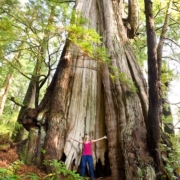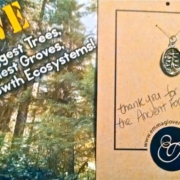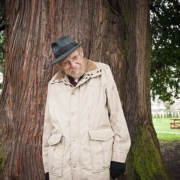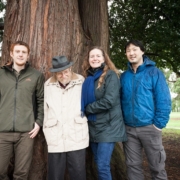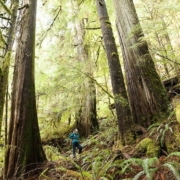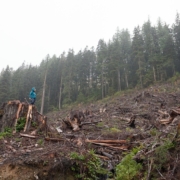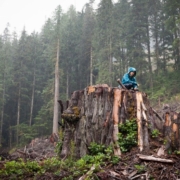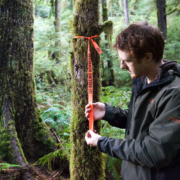November 19, 2014
For Immediate Release
Canada’s Grandest Rainforest at Risk from Old-growth Logging as Survey Tape is discovered in the Heart of the Walbran Valley
Port Renfrew, British Columbia – One of Canada’s most iconic and grandest old-growth temperate rainforests is under threat as signs of potential logging have been discovered in the heart of the Upper Walbran Valley on Vancouver Island. Ancient Forest Alliance (AFA) activists TJ Watt and Jackie Korn recently documented survey tape marked “Falling Boundary” and “Road Location” in the Central Walbran Ancient Forest, one of the last, largely-intact sections of the unprotected portion of the valley.
See new photos of the threatened Central Walbran Ancient Forest, including new “Falling Boundary” survey tape, as well as a recent clearcut a few kilometres farther up the valley at: https://16.52.162.165/photos-media/central-walbran-ancient-forest/
NOTE: Media are free to reprint any photos (photo credit to “TJ Watt” if possible. Contact us if you need higher resolution shots at info@16.52.162.165).
The Surrey-based logging company, the Teal Jones Group, has the logging rights to the area currently at risk.
While most of the Upper Walbran Valley has been heavily fragmented by old-growth logging, two major tracts of ancient forest remain largely unlogged there: The Castle Grove (Canada’s finest ancient redcedar forest) and the Central Walbran Ancient Forest (currently under potential logging threat) which abuts against the boundary Carmanah/Walbran Provincial Park.
“Because of the ideal growing conditions in the region, Canada’s temperate rainforests reach their most magnificent proportions in the Walbran and Carmanah Valleys. It’s our version of America’s redwoods. Unfortunately, the upper half of the Walbran Valley remains open for logging. The area currently threatened, as well as the Castle Grove, make up the most ecologically significant and intact sections left in the Upper Walbran Valley. They must be protected”, stated TJ Watt, Ancient Forest Alliance campaigner and photographer.
So far, Teal Jones has not applied for any cutting or road building permits in the Central Walbran Ancient Forest, according to an email from the Ministry of Forests, Lands, and Natural Resource Operations to the Ancient Forest Alliance. However, the flagging tape clearly denotes the company’s interest in potentially logging the area, although the company appears to still be in “survey and assessment” mode.
The Walbran Valley is about 13,000 hectares in size, with about 5500 hectares of the Lower Walbran Valley protected within the Carmanah-Walbran Provincial Park and about 7500 hectares of the Upper Walbran Valley remaining unprotected. The unprotected Upper Walbran Valley is divided into two “Tree Farm Licences” (TFL’s): TFL 46, held by Teal Jones, and TFL 44, held by Western Forest Products, on Crown lands in the unceded territory of the Pacheedaht Nuu-Cha-Nulth people.
“Across southern Vancouver Island, the remaining unprotected old-growth forests are heavily tattered. The Central Walbran Ancient Forest is still largely intact and represents some of the ‘last of the best’ old-growth temperate rainforest in Canada – to let it get logged would be a national travesty. The BC Liberal government should immediately take steps to protect this area in the Upper Walbran Valley, which has been Ground Zero for the ancient forest movement on southern Vancouver Island for over two decades,” stated Ken Wu, Ancient Forest Alliance executive director.
The new flagging tape is on a largely intact mountainside – with the exception of one clearcut logged in 1992, referred by local conservationists as “Miller’s Monstrosity” – that is several hundred hectares in extent. While small sections of the Central Walbran Ancient Forest are protected within Riparian Reserves and Old-Growth Management Areas, the vast majority of the area is open for logging. The sections of flagging tape identified at this time are primarily to the southwest of the existing Miller’s Monstrosity clearcut, with a small section of tape on the north side of the clearcut, across the river from the famed Castle Grove. The Central Walbran Ancient Forest is a popular and heavily used area by recreationalists, where the main boardwalk trails for hiking, riverside camping area, Emerald Pool swimming area, and the spectacular Fletcher Falls are found.
The area’s old-growth western redcedar, Sitka spruce, and hemlock forests have long been proposed for protection by the environmental movement since the early 1990’s, when the Walbran Valley was “ground zero” for protests by the environmental movement on southern Vancouver Island. The early Walbran Valley protests played an important role in supporting the build-up towards the massive Clayoquot Sound protests near Tofino on Vancouver Island in 1993. Conservationists are calling for the area’s protection through a new provincial conservancy designation.
The area currently under threat, the Central Walbran Ancient Forest, includes the Tolkien Giant, a 16 foot (5 metre) diametre redcedar that is one of the largest trees in the province, growing within the Tolkien Grove of dozens of giant redcedars. While the Tolkien Grove is protected within an Old-Growth Management Area, the new flagging tape indicates that potential logging could occur on the adjacent mountainside above the grove and come to within a few dozen meters of it, threatening the area’s wildlife habitat with fragmentation and erosion/siltation from the mountainside during heavy rains.
The Central Walbran Ancient Forest, Castle Grove, and adjacent unprotected forests were designated as a “Special Management Zone” (SMZ) by the BC government in 1994. The SMZ is supposed to be managed to maintain its environmental and biodiversity values – however, numerous destructive clearcuts have tattered much of the SMZ over the past 20 years.
Across the river from the new flagging tape is the Castle Grove, the finest, unprotected stand of monumental old-growth western redcedar trees in Canada. Teal-Jones had flagged part of the Castle Grove for logging in the summer of 2012, but after a public campaign by the Ancient Forest Alliance, it was reported in November of 2012 that the company was not intending to log the Castle Grove. See: https://16.52.162.165/news-item.php?ID=515 and video https://www.youtube.com/watch?v=lHnG_sC4oms
Ecological surveys done in the Walbran Valley have revealed the presence of species at risk including marbled murrelets, Queen Charlotte goshawks, red-legged frogs, Vaux’s swifts, and Keen’s long-eared myotis, as well as cougars, wolves, black bears, elk, black-tailed deer, steelhead and coho salmon.
Old-growth forests are vital to sustain endangered species, climate stability, tourism, clean water, wild salmon, and the cultures of many First Nations.
On BC’s southern coast, satellite photos show that at least 75% of the original,productive old-growth forests have been logged, including over 90% of the valley bottoms where the largest trees grow. See maps and stats at: https://16.52.162.165/ancient-forests/before-after-old-growth-maps/
The Ancient Forest Alliance is calling on the BC government to implement a comprehensive science-based plan to protect BC’s endangered old-growth forests, and to also ensure a sustainable, value-added second-growth forest industry.
In order to placate public fears about the loss of BC’s endangered old-growth forests, the BC government’s PR-spin typically inflates the amount of remaining old-growth forests by including hundreds of thousands of hectares of marginal, low productivity forests growing in bogs and at high elevations with smaller, stunted trees, lumped in with the productive old-growth forests, where the large trees grow (and where most logging takes place). “It’s like including your Monopoly money with your real money and then claiming to be a millionaire, so why curtail spending?” stated the Ancient Forest Alliance’s Ken Wu.

